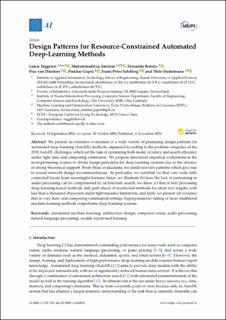Please use this identifier to cite or link to this item:
https://doi.org/10.21256/zhaw-20804| Publication type: | Article in scientific journal |
| Type of review: | Peer review (publication) |
| Title: | Design patterns for resource-constrained automated deep-learning methods |
| Authors: | Tuggener, Lukas Amirian, Mohammadreza Benites de Azevedo e Souza, Fernando von Däniken, Pius Gupta, Prakhar Schilling, Frank-Peter Stadelmann, Thilo |
| et. al: | No |
| DOI: | 10.3390/ai1040031 10.21256/zhaw-20804 |
| Published in: | AI |
| Volume(Issue): | 1 |
| Issue: | 4 |
| Page(s): | 510 |
| Pages to: | 538 |
| Issue Date: | 6-Nov-2020 |
| Publisher / Ed. Institution: | MDPI |
| ISSN: | 2673-2688 |
| Language: | English |
| Subjects: | Automated machine learning; Architecture design; Computer vision; Audio processing; Natural language processing; Weakly supervised learning |
| Subject (DDC): | 006: Special computer methods |
| Abstract: | We present an extensive evaluation of a wide variety of promising design patterns for automated deep-learning (AutoDL) methods, organized according to the problem categories of the 2019 AutoDL challenges, which set the task of optimizing both model accuracy and search efficiency under tight time and computing constraints. We propose structured empirical evaluations as the most promising avenue to obtain design principles for deep-learning systems due to the absence of strong theoretical support. From these evaluations, we distill relevant patterns which give rise to neural network design recommendations. In particular, we establish (a) that very wide fully connected layers learn meaningful features faster; we illustrate (b) how the lack of pretraining in audio processing can be compensated by architecture search; we show (c) that in text processing deep-learning-based methods only pull ahead of traditional methods for short text lengths with less than a thousand characters under tight resource limitations; and lastly we present (d) evidence that in very data- and computing-constrained settings, hyperparameter tuning of more traditional machine-learning methods outperforms deep-learning systems. |
| URI: | https://digitalcollection.zhaw.ch/handle/11475/20804 |
| Fulltext version: | Published version |
| License (according to publishing contract): | CC BY 4.0: Attribution 4.0 International |
| Departement: | School of Engineering |
| Organisational Unit: | Institute of Computer Science (InIT) |
| Published as part of the ZHAW project: | Ada – Advanced Algorithms for an Artificial Data Analyst |
| Appears in collections: | Publikationen School of Engineering |
Files in This Item:
| File | Description | Size | Format | |
|---|---|---|---|---|
| 2020_Tuggener-etal_Design-patterns-deep-learning-methods_AI.pdf | 6.28 MB | Adobe PDF |  View/Open |
Show full item record
Tuggener, L., Amirian, M., Benites de Azevedo e Souza, F., von Däniken, P., Gupta, P., Schilling, F.-P., & Stadelmann, T. (2020). Design patterns for resource-constrained automated deep-learning methods. Ai, 1(4), 510–538. https://doi.org/10.3390/ai1040031
Tuggener, L. et al. (2020) ‘Design patterns for resource-constrained automated deep-learning methods’, AI, 1(4), pp. 510–538. Available at: https://doi.org/10.3390/ai1040031.
L. Tuggener et al., “Design patterns for resource-constrained automated deep-learning methods,” AI, vol. 1, no. 4, pp. 510–538, Nov. 2020, doi: 10.3390/ai1040031.
TUGGENER, Lukas, Mohammadreza AMIRIAN, Fernando BENITES DE AZEVEDO E SOUZA, Pius VON DÄNIKEN, Prakhar GUPTA, Frank-Peter SCHILLING und Thilo STADELMANN, 2020. Design patterns for resource-constrained automated deep-learning methods. AI. 6 November 2020. Bd. 1, Nr. 4, S. 510–538. DOI 10.3390/ai1040031
Tuggener, Lukas, Mohammadreza Amirian, Fernando Benites de Azevedo e Souza, Pius von Däniken, Prakhar Gupta, Frank-Peter Schilling, and Thilo Stadelmann. 2020. “Design Patterns for Resource-Constrained Automated Deep-Learning Methods.” Ai 1 (4): 510–38. https://doi.org/10.3390/ai1040031.
Tuggener, Lukas, et al. “Design Patterns for Resource-Constrained Automated Deep-Learning Methods.” Ai, vol. 1, no. 4, Nov. 2020, pp. 510–38, https://doi.org/10.3390/ai1040031.
Items in DSpace are protected by copyright, with all rights reserved, unless otherwise indicated.